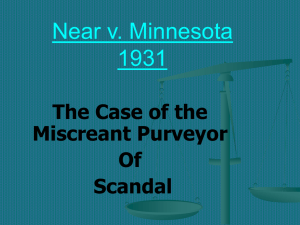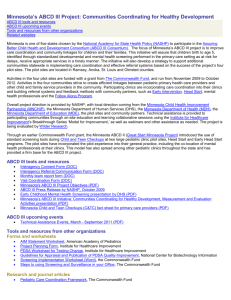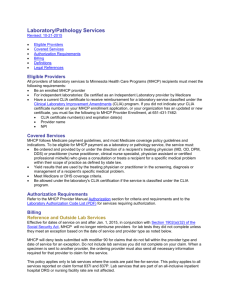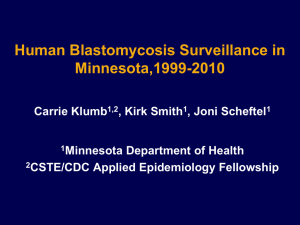Primary Care in Minnesota - Alliance for Health Reform
advertisement
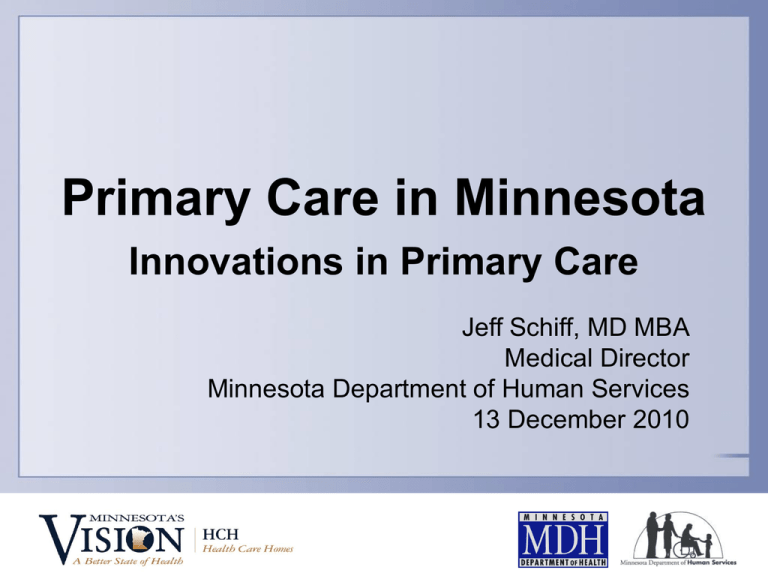
Primary Care in Minnesota Innovations in Primary Care Jeff Schiff, MD MBA Medical Director Minnesota Department of Human Services 13 December 2010 What’s so different up there? • • • • Low rate of uninsured Collaborative non-profit culture Highly integrated delivery systems Strong primary care base And … 2008 percent of GDP in healthcare National 15.1% Minnesota 13.4% Relatively healthy population Underpinnings of Primary Care Delivery Reform • • • • Patient and Family Centered Care “Agency” role of providers Advocate vs. steward Creating and regulating the right market in health care “That a power imbalance exists between doctors and patients has been readily acknowledged…. However the effects of this asymmetry can be mitigated through the establishment of trust between doctor and patient” - Loree K Kallianinen,MD Primary Care in Minnesota – Health Care Home • 2003 –HRSA grant to provide medical home for children with special health care needs • 2007- first Minnesota legislation to pay for care coordination • 2008- major Minnesota health care reform legislation including Health Care Home Minnesota Health Care Home Program 2008 Enabling legislation • Designation of criteria in state rule • Active clinic certification process • Complexity-adjusted multi-payer payment methodology • Learning collaborative • Outcomes reporting and results required for recertification Services required of certified Health Care Homes • Access and communication standards – Availability of patient registry information – Appointment availability/ triage capacity • Registry functionality • Care planning • Care coordination – Transition coordination – Coordination with community agencies – Dedicated care coordination capacity • Practice based quality improvement – Patient and family centered care Complexity adjusted payment methodology • Provider determined tier assignment • Based on the number of conditions groups (e.g. endocrine, cardiovascular) that are chronic, severe, and requiring a care team for optimal management • Two supplemental complexity factors added (non English as primary language and significant mental illness) • Work of providing a HCH (and payment rate) estimated based on this complexity • Modeling estimation of provider tier assignment derived from claims based risk adjustment software (also to be used to audit provider tier assignment) Estimated Distribution: MHCP FFS Figure 2: Distribution of Member Months by Count of Major Condition Groups - Fee-for-Service MHCP Population State Fiscal Year 2008 Count of M ajor Condition Groups 9% 12% 0 (Tier 0) 1-3 (Tier 1) 4-6 (Tier 2) 50% 7-9 (Tier 3) 10+ (Tier 4) 17% 12% HCH payment • Payment rates range from $10-$60 PMPM • All Medicaid, state employees and privately insured included in a “manner consistent with…” that developed by DHS • ~2% of the total health care spend on patients • Cost neutrality assumed by the legislature Minnesota and federal health care reform------Health Care Home • Multipayer Advanced Primary Care Practice (MAPCP) Demonstration • ACA section 2703 – expanded federal Medicaid match MAPCP • Cost neutrality $14.43 PMPM • Medicare FFS to join state efforts • Effect in the state • Critical mass • Credibility of program • Common expectations for evaluation Key Design Feature #1 (contd.): Statewide Scope and “Critical Mass” of Payment SOURCE: Adapted from MDH Health Economics Program, Medicare enrollment data and SEGIP enrollment data ACO components – our program as the logical bridge • • • • Build on primary care/ care coordination Attribution Risk Total cost of care methodology/ Gain sharing • Measurement • Our complex population ACO in the ACA ACO ≠ capitation • Center for Medicare and Medicaid Innovation • Medicare shared savings • Pediatric ACO • Safety net hospital ACO Key Program Information: Minnesota Department of Health (MDH) http://www.health.state.mn.us/healthreform/homes/index.html Minnesota Department of Human Services (DHS) http://www.dhs.state.mn.us/healthcarehomes


